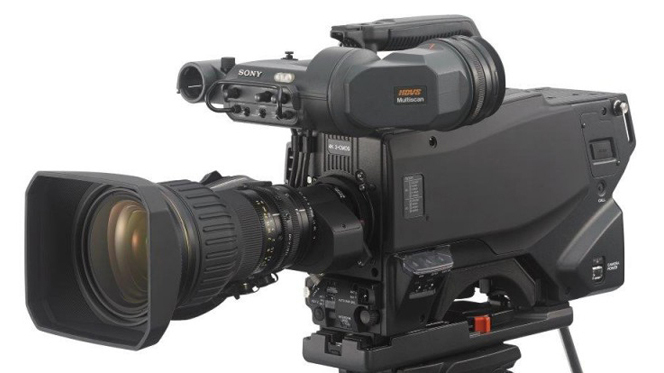MLB 2018: A Clearer Image
BALTIMORE—With the 2018 Major League Baseball (MLB) season about to get underway, it’s time for the fans to see what video upgrades are being offered for their viewing pleasure. And they’ll find out after a close play at the plate, a devastating curveball or the look in a player’s eyes—from many angles.
That advancement can be summed up in two words: Super slo-mo (SSM).
SSM is being brought to the forefront of broadcasts by MLB’s three main mobile unit providers: Mobile TV Group (MTvG), Game Creek Video and NEP U.S. Mobile Units. That also means more high-speed cameras will capture the action at very high frame rates, while the various networks, regional sportsnets (RSNs) and viewers wait for “safe” or “out” calls from the MLB Network nerve center in Secaucus, N.J., the home of MLB Network, or get deeper, more concise reaction shots that underscore the passion for the national pastime.
Baseball is also important in a mobile industry where trucks are getting more expensive and providers need that steady home schedule of 81 games per year to create revenue; however, HD costs to the RSNs are leveling off, and broadcasters are contemplating hiring less expensive, non-union crews.
4K UNDERWAY
The pie in the MLB market is sliced into but three large slices, with the largest by far belonging to MTvG. The company operates about 35 units for Fox Sports and ROOT Sports at 18 MLB ballparks This includes one 4K truck, the 39 Flex, that “constantly goes coast-to-coast,” said Nick Garvin, COO for Englewood, Colo.-based MTvG, plus several 1080p trucks. It is currently building the 43 Flex, which will be used by ROOT Sports for Colorado Rockies home and selected away broadcasts.
“[No. 43] is a 1080p-capable truck and will have four super slo-mos,” Garvin said. “That’s the big push this year. We have four super slo-mo cameras on four trucks and two super slo-mos on two of the others.” MTvG has other trucks that are “4K ready,” but are not licensed as such, since “the only broadcasters doing 4K baseball are Fox Sports and MLB Network,” Garvin said.
Get the TV Tech Newsletter
The professional video industry's #1 source for news, trends and product and tech information. Sign up below.

The SSM push is happening because the Texas Rangers and the Tampa Bay Rays (units 38 Flex and 40 HDX, respectively) were the only teams that used four super slo-mo cameras last year, which were in demand by the RSNs due to an increasingly sophisticated viewership.
“Two weren’t enough, because the cameras are aimed at different things; so this year, we have a total of seven trucks with four” SSMs, said Garvin. “Cameras with the record and playback system make the whole chain, which runs at six times normal speed,” which also moved MTvG to buy four new 12-channel EVSs and Grass Valley Dynos for every mobile unit. “We buy about 10 every year, as well as 30-40 Sony 4300 and GVG 86 [cameras], as we’re on a constant build cycle at headquarters. We build four main units a year.”
Garvin also noted that the networks are working with MLB to offer viewers a more comprehensive experience. “This season, we’ll see the regular broadcast with bigger lenses, plus StatCast, PitchCast,” etc. “Even for RSNs, viewers expect the optimum experience, any place, any time.”
‘BIG DEAL’ UPGRADES
Hudson, N.H.-based Game Creek Video is one of two truck providers that contracts with the regional carriers of six MLB teams: the Boston Red Sox, New York’s Yankees and Mets, Baltimore Orioles, Washington Nationals and Houston Astros.
[Facebook, MLB Play Ball on Weekly Broadcast of Games]
Garrett Sullivan, senior vice president of production and finance, said the deals with each RSN are “a little different” and that Game Creek assigns No. 94 in Boston for NESN; Yogi in New York for Yes Network, and Webby for SNY; Chesapeake in Baltimore and Washington for MASN; and Apollo for Fox Sports Houston.
Game Creek works with Fox Sports, as well as MLB Network’s Showcase Game of the Week, “which will air 26 games in 4K HDR,” said Sullivan, adding that Fox will also carry a handful of 4K games.
As for what’s inside the trucks, the “newest, latest and greatest 4K HDR is on the Riverhawk for MLB Showcase,” he said, “and we’ve joined with AT&T/DirectTV to make it HDR capable. The only way that’s delivered to the home is via DirecTV.”

This year’s upgrades to the Riverhawk, according to Sullivan, include 10 Sony HDC 4300s, seven Sony HDR BVME 171E monitors, Tektronix HDR scopes, HDR cross-conversion gear from Evertz, five 12-channel EVS XT 4Ks and the Grass Valley Kayenne K-frame with the “crowning jewel,” the 4K SSM Sony 4800.
All told, the additions will lead to a more refined broadcast. “MLB is mandating that regional trucks have at least two SSM cameras, and some clients require four,” Sullivan said. “It’s all part of telling the story of breaking bats, seams of the ball, curves breaking, a runner’s cleat touching the base and the great plays.”
EASIER TO RECORD
The setup with NEP, of Pittsburgh, is similar to that of Game Creek. NEP contracts with the regional carriers of six teams, including the Seattle Mariners, San Francisco Giants, Oakland A’s, Los Angeles Dodgers, and Chicago’s Cubs and White Sox, as well as ESPN for its Sunday, Monday and Wednesday game broadcasts.
NEP U.S. Mobile Units President Glen Levine said the company supplies 19 mobile units for baseball, with a variety of the trucks recently accentuated with various “technological advances.” The units mainly contain Sony and Grass Valley cameras, Calrec audio consoles, EVS servers, Grass Valley Kayenne switchers and various routers.
NEP’s EN2 rolls in for the ESPN Sunday night games and is streamlined with a plug-and-play setup, “to heighten efficiencies, with recallable files, A and B fiber interconnect between units and a consistent crew,” said Levine.
NCP 10 does ESPN’s Monday and Wednesday games, and contains similar technology, aside from Utah Scientific routers; the SS18 supports Turner, which broadcasts 10 Sunday national games.
Levine, as well, noted “the biggest production adds” for this season are in the SSM vein; the ROOT (which covers the Mariners) and ESPN trucks each contain four SSM cameras, and Comcast added two for all regions. “It’s also easier to record content than ever,” said Levine. “The viewer wants to see the different angles. Since technology is always improving, the more replays you can have in SSM, the better.”
SSM FOR ALL
From the network perspective, Michael Connelly, senior vice president and executive producer for Fox Sports, discussed the heightened use of SSM, as well as other advances to broadcasts.
“Game Creek handles the east coast and Lyon Video handles some in Ohio, but MTvG does most of our work,” he said. “So, for instance, we purchased full units from Vizrt for the MTvG trucks, which MTvG services; [they provide] up to three channels of graphics for all events; a couple of years ago, when we moved to the Grass Valley LDX cameras, we bought the first 14 that were manufactured and also installed them in the MTvG trucks; now they’re standard with every new MTvG unit.”
Connelly also appreciates that, unlike other sports, baseball is played most days. “It’s a stable broadcasting option, due to all the home games, so we have an opportunity to build what equates to a proper studio,” he said. “With the new technology from the SSM manufacturers, we’re now able to employ it for everyday games instead of just special ‘jewel’ events, like the MLB All-Star Game and the World Series. It’s easier to use and you can see up to six SSM cameras on a regular telecast.”
But that’s not all. Another big addition to Fox Sports broadcasts is increased bandwidth.
“We’ve upgraded every MLB stadium with two 1 gig IP lines,” Connelly said. “That provides a few boosts to our broadcasts: a redundancy path as a backup, in case one path fails, one to master control in The Woodlands, Texas, the other to the appropriate regional studio; second, it allows integration from the studio into the game broadcast, in real time, throughout the broadcast; and third, real-time network return to the remote site for the production team and talent. That’s a big add, because it allows our production team and talent to view the broadcast in real time and eliminates the prior 8-second delay.”
Fox is also integrating StatCast in the broadcast this year, “which will be a first,” he said. “You’ll see shifts in the outfield, the spin rate on a curve ball, tracers on HRs and their distance, all driven by game data,” which is believed to be a first for Fox RSNs.
“We’ll also be testing file sharing between the studio and the stadium, and it won’t have to be facilitated by the people in the truck,” Connelly said. “That makes it faster.”
[Fox Sports Readies the Field for World Series]
And, in the end, technology making things faster facilitates blossoming creativity.
“[Broadcasting a game] is all about storytelling,” Garvin said, “and that includes using technology to bring the close plays even closer for our audiences.”
TIME TO DOWNSIZE
Fred Gerling is another invested observer who appreciates the demand for mobile units baseball creates. But he’s wondering if today’s business model could evolve.
“Baseball uses small trucks in spring training, such as the 45-foot, double-expando with a C/Ku-band link on the back,” said Gerling, president of Gerling & Associates, a mobile unit manufacturer in Sunbury, Ohio. “So I would think that more baseball broadcasters would opt for Remote Integration (REMI) production suites. I’ve heard the conversation about doing baseball from that standpoint, since the picture is transmitted back to a big facility, but I don’t see it happening.”
Gerling is also hearing questions about whether big union crews in the field are needed. “If you have streaming video that goes back to a big network facility in New York, a big union city, it gets expensive to use union crew,” he said.
That begs the question about why broadcasters aren’t going non-union. “A truck is crewed by the owner, who flies people and pays for accommodations,” Gerling said. “If the owner hires non-union crew, they’re more affordable, even if you fly them in.”
But as of today, he thinks broadcasters will continue to use the large trucks.
“Many people think baseball isn’t as popular as it was, but domestically and worldwide, plenty of people are watching,” he said. “People have no idea where those satellite links end up.”
Mark R. Smith has covered the media industry for a variety of industry publications, with his articles for TV Technology often focusing on sports. He’s written numerous stories about all of the major U.S. sports leagues.
Based in the Baltimore-Washington area, the byline of Smith, who has also served as the long-time editor-in-chief for The Business Monthly, Columbia, Md., initially appeared in TV Technology and in another Futurenet publication, Mix, in the late ’90s. His work has also appeared in numerous other publications.

